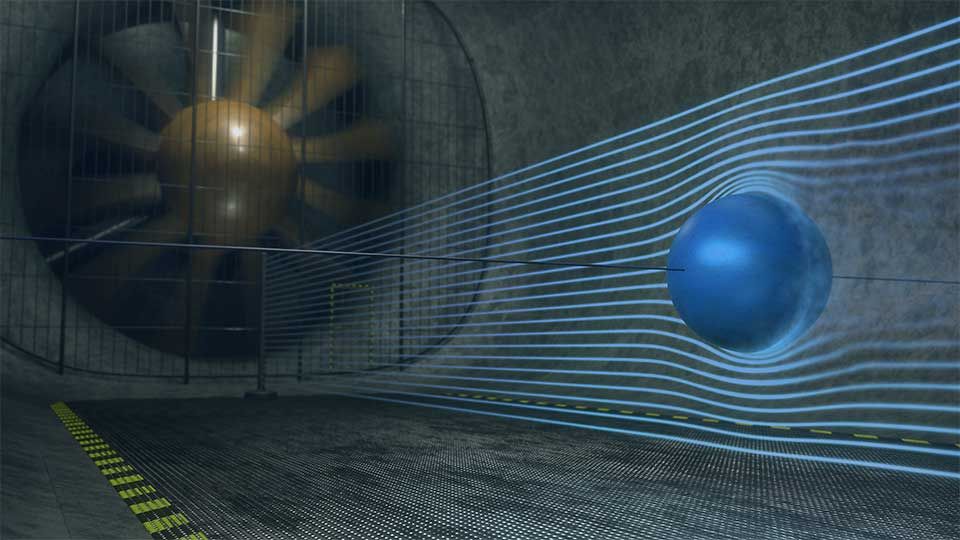
Fluid Dynamic Drag of Immersed Bodies with Ansys Fluent
Analysis in virtual wind tunnel

In this training, you will learn about aerodynamic and hydrodynamic modeling approaches and receive best practice tips for their solution. This training is offered as a 1-day course.
Duration
1 day
Prerequisites
Basic knowledge of Ansys Fluent
Software used
Ansys CFD
- Understanding physical effects involved in objects with external flows
- Deepening knowledge of aerodynamics and hydrodynamics through practical exercises
- Comparing simulation with experimentation
- Specifics of simulations involving strong flow separation
Description
Aerodynamics and hydrodynamics describe the influence of forces acting on bodies immersed in surrounding air or water. By determining the resulting forces and their causes, you gain insights for the development of your design. Through simulation, you can achieve targeted reduction of resistance by making appropriate geometric adjustments. Typical applications for simulating external flows are not only found in aircraft, ship, or automotive engineering; for the design of antennas, wind turbines, or buildings, fluid dynamic resistance is also a crucial factor to consider.
In this course, you will learn about the forces exerted by external flows. Through practical examples of simulating external flows in air and water, you will deepen your knowledge of aerodynamics and hydrodynamics. You will receive best-practice tips, regarding the precise determination of the boundary layer, model settings, and the evaluation of your simulation results. Additionally, you will receive practical advice for simulations involving strong flow separation. Building on your initial experiences with Ansys Fluent, we will further explore the basic functionalities in this training as a foundation for a solid introduction to aerodynamic and hydrodynamic simulations.
Detailed agenda for this 1-day training
Day 1
01 Main principles of aerodynamics
- Basics: Pressures in fluid mechanics
- Introduction to boundary layer theory
- Turbulence and flow separation
- Workshop: Virtual wind tunnel
02 Transition from model to reality
- Dimensionless numbers
- Friction and pressure forces
- Various types of resistances
- Workshop: Analysis of a NACA profile
03 Characteristics of liquids
- Formation of cavitation
- Reliable detection of cavitation
- Modeling approaches for cavitation
- Workshop: Sensitivity of minimum pressure to geometry
04 Simulating transient flows in a steady state
- Characteristics of transient flows
- Vortex frequency and Strouhal Number
- Limitations of steady-state Simulations
- Workshop: Tackling turbulence with RANS
Your Trainers

Dr.-Ing. Fabian Findeisen

Kevin Baur

Johannes Raitmair
Placement in the CADFEM Learning Pathway
Participant data
Additional information
Commentary
Whether eLearning, classroom courses, live online training or customized workshops - together we identify the best option for you.
Do you have questions on the training?
If you book through your university, you will receive a 50% discount on the stated fee on training courses and eLearning courses.
For more information on the validity and how booking with the code ACADEMIC50 works, please visit our page on training for academic users.
Straight after you sign up, an automatic confirmation of receipt will be sent to the email addresses you provided. Once you have successfully verified the data you provided, you will receive your personalized sign-up confirmation, containing further information on course fees, the billing address, etc., by email within two to three working days.
As soon as the minimum number of attendees has been reached, you will receive a final training confirmation containing further information. If you have booked an on-site training, we recommend that you wait until you have received this final confirmation before booking your travel and accommodation.
If the minimum number of attendees is not reached, we reserve the right to cancel the training seven days before it is due to start at the latest. We are happy to inform you on changing your booking to an alternative date. Please note that we accept no liability for hotel or travel bookings that attendees have already made.
Usually the training courses start at 9:00 am and end at 5:00 pm of the respective local time. The actual course times will be stated in the booking confirmation. Please note that, depending on the training host, there may be a possible time shift between your and the provider's local time. Therefore all local times are provided with the valid time shift to Greenwich Mean Time (GMT).




